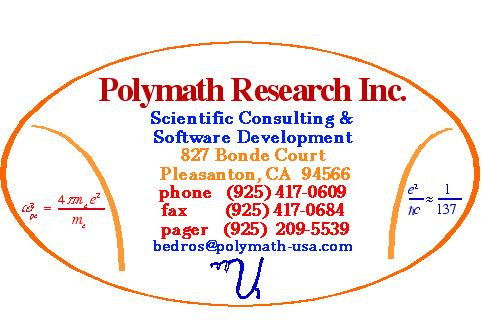
Polymath Research Inc.
Scientific Consulting and Software Development

More importantly, we have undertaken the much more challenging problem of simultaneously simulating carrier, heat and photon transport in semiconductor laser devices using a FEMLAB based photonics modeling package which we are building at Polymath. Through SBIR funding, we collaborate with two national labs, three universities and a number of industrial concerns so as to compare our simulation results with measurements from actual devices. This iterative process should yield comprehensive photonics device modeling tools that are well tested against experimental data.
Another area of focus is nonlinear plasma physics and kinetic plasma modeling using wavelet tools and adaptive wavelet techniques. Numerous applications in pulsed power devices, ICF and photonics device modeling motivate this work. We collaborate with four National Labs and a number of universities on this work. A recent presentation from March 2002, at the Bay Area Scientific Computing conference shows how to use multiresolution analysis together with Wigner functions to choose best wavelet bases for nonlinear physics simulation applications. This presentation includes the solution of a randomly forced Burgers equation after the toy problem of a band limited double wavepacket with carriers is treated. A second presentation also from march 2002 covers applications of wavelet and multiresolution analysis in Fast Z Pinch Research, the Magnetic Rayleigh Taylor instability and turbulence.
We also champion a number of laser-plasma interaction experiments (see for example IFSA 1999), conducted on Omega at LLE as part of the DoE NLUF program and on Trident as part of the DoE Science Grants program and theoretical interpretations (see for example NonMaxwellian EPWs and IAWs and DLMs and SRS). At the latest HEDP symposium in October of 2001 in Livermore, an overall picture of 3 important kinetic effects usually swept under the rug of LPI "pragmatic" codes were highlighted. More recently, at the Wente Vineyards "SRS/SBS Saturation: Where do we go from here?" Workshop, the following two presentations described Optical Mixing Controlled Stimulated Scattering Instability Physics as it relates to EPW/TEAW and IAW generation and SRS Suppression.
The computational tools used in our work are Mathematica, MATLAB, FEMLAB, IDL, Fortran77 and Fortran 90,and parallelization is done via MPI. The hardware we use in house are a cluster of 8 dual processor G4 450 MHz Mac workstations interconnected via a fast switch called Polymath 2000. The system has 8 Gbytes of memory and runs Appleseed. We also use Sun Ultra 60 dual processor workstations, Mac PowerPCs and PowerBooks.
We are currently recruiting computational physicists and engineers with expertise in electromagnetic wave propagation and interaction problems. A strong background in semiconductor physics, electro-optics or plasma physics modeling is essential. Expertise in parallel computing, Fortran and higher level languages are highly desirable.
We are located in the San Francisco Bay Area. Qualified candidate are urged to apply by contacting us.